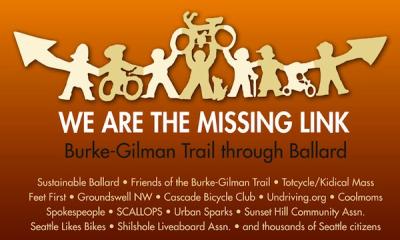
By Kevin Carrabine
Seattle’s diverse neighborhoods are a source of pride and joy, and each contributes something unique to the weave of our civic fabric. Ballard is foremost among them, and a place I’m proud to call home.
Unfortunately, for Ballardites who want to travel to and from other neighborhoods in ways that limit pollution, keep us healthy, and set an example for our children, the streets often feel too dangerous. We are forced to weave through fast-moving traffic or negotiate poorly maintained or absent sidewalks and bikeways.
A notable exception is the Burke-Gilman Trail. The trail starts at Golden Gardens and winds through our region for nearly 17 miles – a spectacular ribbon of right of way that any city would be proud to own for its citizens. Tens of thousands of Ballardites and Seattlites walk, run, skate, and bike the Burke-Gilman each year to commute to work, to go to school, to run daily errands, to take their families to the park, or to travel between neighborhoods. Freed of the hassles of car traffic and hills, trail users find a transportation oasis amidst the chaos of the city streets, and a very functional one at that.
Yet there remains a glaring gap in the trail: over a mile-long “missing link” from Ballard’s Fred Meyer to the Chittenden Locks.
While this causes significant navigational problems for walkers and bicyclists, the gap is more than inconvenient and embarrassing – it’s downright dangerous. The gap forces trail users to cross Shilshole Avenue and the most dangerous railroad crossings in the city. It pushes people into complex intersections and unprotected roads with fast-moving traffic. Numerous crashes within the missing link section happen every year, resulting in completely preventable injuries.
Why hasn’t it been fixed? Didn’t Ballardites identify the missing link as a neighborhood plan priority in the late-1990s? Haven’t mayors all the way back to Paul Schell and Greg Nickels, along with the City Council in 2003, made closing the gap a top priority? Wasn’t there a City Council-approved compromise alignment designed and completely funded, ready for construction in mid-2009? The answer to all of these is yes.
All the pieces were in place to move us forward on the trail. It was completely in the public right of way, driveway crossings for businesses were improved, and drainage, roadway, intersection improvements were all embedded in the project. A federal grant had been secured to pay for it – your tax dollars at work for you. So what happened?
Well, a handful of people have clogged things up with lobbying and lawsuits – and they pledge to continue fighting this connection, no matter how much our community wants it. This despite having signed legal documents acknowledging the City’s right to build the trail as proposed, and the engineering efforts made by the City to satisfy each and every access and operational issue raised by adjacent property owners.
While opponents of building the missing link cite safety concerns, the City has studied the area for more than 15 years, and concluded that closing the gap is the best solution for safety. As a nurse practitioner, I make public health and safety my career – and I have no doubt they’re right.
The litany of lawsuits means further delays, which means more crashes, more dollars wasted, and more ill will generated. It means Seattle is at risk of losing the federal grant money for the project. It means perpetuating the safety, navigation, and traffic conflict problems we’ve known for decades, and it means fewer Ballardites have the transportation choices they and their families desperately need and have been demanding.
Ballard deserves better. We need safe, convenient transportation options that connect us to our neighborhoods to the east, west, and south, and finishing the Burke-Gilman is critical to that network. Simply put, it’s time for the gap to go.
Kevin Carrabine has lived in Ballard for 24 years. He co-founded Friends of the Burke-Gilman Trail and serves on the Board of the Cascade Bicycle Club.
Share this post
